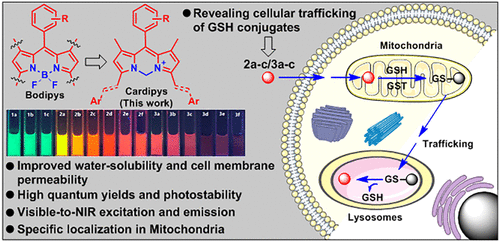当前位置:
X-MOL 学术
›
J. Am. Chem. Soc.
›
论文详情
Our official English website, www.x-mol.net, welcomes your
feedback! (Note: you will need to create a separate account there.)
Carbon-Dipyrromethenes: Bright Cationic Fluorescent Dyes and Potential Application in Revealing Cellular Trafficking of Mitochondrial Glutathione Conjugates
Journal of the American Chemical Society ( IF 14.4 ) Pub Date : 2020-09-18 , DOI: 10.1021/jacs.0c06916 Hongxing Zhang 1 , Jing Liu 1 , Yuan-Qiang Sun 2 , Mengxing Liu 1 , Wei Guo 1
Journal of the American Chemical Society ( IF 14.4 ) Pub Date : 2020-09-18 , DOI: 10.1021/jacs.0c06916 Hongxing Zhang 1 , Jing Liu 1 , Yuan-Qiang Sun 2 , Mengxing Liu 1 , Wei Guo 1
Affiliation

|
Boron-dipyrromethenes (Bodipys), since first reported in 1968, have emerged as a fascinating class of dyes in the past few decades due to their excellent photophysical properties including bright fluorescence, narrow emission bandwidth, resistance to photobleaching, and environment insensitivity. However, typical Bodipys are highly lipophilic, which often results in the nonfluorescent aggregates in aqueous solution, and also severely limits their bioavailability to cells and tissues. In this work, based on a simple one-atom BC replacement in Bodipy scaffold, we present a new class of carbon-dipyrromethenes (Cardipys for short) fluorescent dyes with tunable emission wavelengths covering the visible and near-infrared regions. These Cardipys not only retain excellent photophysical properties of conventional Bodipys, but also show improved water solubility and photostability due to their cationic character. Moreover, the cationic character also makes them extremely easy to penetrate cell membrane and specifically accumulate into mitochondria without resorting to any mitochondria-targeted groups. Interestingly, several Cardipys bearing active styryl groups could serve as fluorescent indicators to map cellular trafficking of the glutathione conjugates produced within mitochondria under the catalysis of glutathione S-transferase (GST), thus showing potentials in either exploring the detoxification mechanism of mitochondrial GST/GSH system or evaluating the drug resistance of cancer cells that is closely related with GST activity.
中文翻译:

Carbon-Dipyrromethenes:明亮的阳离子荧光染料及其在揭示线粒体谷胱甘肽结合物的细胞运输中的潜在应用
Boron-dipyrromethenes (Bodipys) 自 1968 年首次报道以来,由于其出色的光物理特性,包括明亮的荧光、窄的发射带宽、抗光漂白性和环境不敏感性,在过去的几十年中已成为一类引人入胜的染料。然而,典型的 Bodipys 是高度亲脂性的,这通常会导致水溶液中的非荧光聚集体,也严重限制了它们对细胞和组织的生物利用度。在这项工作中,基于 Bodipy 支架中一个简单的单原子 B→C 替代,我们提出了一类新的碳二吡咯亚甲基(简称 Cardipys)荧光染料,其具有覆盖可见光和近红外区域的可调发射波长。这些 Cardipys 不仅保留了传统 Bodipys 的优异光物理特性,但由于它们的阳离子特性,还显示出改善的水溶性和光稳定性。此外,阳离子特性还使它们非常容易穿透细胞膜并专门积累到线粒体中,而无需求助于任何线粒体靶向组。有趣的是,一些带有活性苯乙烯基团的 Cardipys 可以作为荧光指示剂来绘制在谷胱甘肽 S-转移酶 (GST) 催化下线粒体内产生的谷胱甘肽结合物的细胞运输,从而显示出探索线粒体 GST/GSH 解毒机制的潜力系统或评估与 GST 活性密切相关的癌细胞的耐药性。阳离子特性也使它们非常容易穿透细胞膜并专门积累到线粒体中,而无需求助于任何线粒体靶向组。有趣的是,一些带有活性苯乙烯基团的 Cardipys 可以作为荧光指示剂来绘制在谷胱甘肽 S-转移酶 (GST) 催化下线粒体内产生的谷胱甘肽结合物的细胞运输图,从而显示出探索线粒体 GST/GSH 解毒机制的潜力系统或评估与 GST 活性密切相关的癌细胞的耐药性。阳离子特性也使它们非常容易穿透细胞膜并专门积累到线粒体中,而无需求助于任何线粒体靶向组。有趣的是,一些带有活性苯乙烯基团的 Cardipys 可以作为荧光指示剂来绘制在谷胱甘肽 S-转移酶 (GST) 催化下线粒体内产生的谷胱甘肽结合物的细胞运输图,从而显示出探索线粒体 GST/GSH 解毒机制的潜力系统或评估与 GST 活性密切相关的癌细胞的耐药性。
更新日期:2020-09-18
中文翻译:

Carbon-Dipyrromethenes:明亮的阳离子荧光染料及其在揭示线粒体谷胱甘肽结合物的细胞运输中的潜在应用
Boron-dipyrromethenes (Bodipys) 自 1968 年首次报道以来,由于其出色的光物理特性,包括明亮的荧光、窄的发射带宽、抗光漂白性和环境不敏感性,在过去的几十年中已成为一类引人入胜的染料。然而,典型的 Bodipys 是高度亲脂性的,这通常会导致水溶液中的非荧光聚集体,也严重限制了它们对细胞和组织的生物利用度。在这项工作中,基于 Bodipy 支架中一个简单的单原子 B→C 替代,我们提出了一类新的碳二吡咯亚甲基(简称 Cardipys)荧光染料,其具有覆盖可见光和近红外区域的可调发射波长。这些 Cardipys 不仅保留了传统 Bodipys 的优异光物理特性,但由于它们的阳离子特性,还显示出改善的水溶性和光稳定性。此外,阳离子特性还使它们非常容易穿透细胞膜并专门积累到线粒体中,而无需求助于任何线粒体靶向组。有趣的是,一些带有活性苯乙烯基团的 Cardipys 可以作为荧光指示剂来绘制在谷胱甘肽 S-转移酶 (GST) 催化下线粒体内产生的谷胱甘肽结合物的细胞运输,从而显示出探索线粒体 GST/GSH 解毒机制的潜力系统或评估与 GST 活性密切相关的癌细胞的耐药性。阳离子特性也使它们非常容易穿透细胞膜并专门积累到线粒体中,而无需求助于任何线粒体靶向组。有趣的是,一些带有活性苯乙烯基团的 Cardipys 可以作为荧光指示剂来绘制在谷胱甘肽 S-转移酶 (GST) 催化下线粒体内产生的谷胱甘肽结合物的细胞运输图,从而显示出探索线粒体 GST/GSH 解毒机制的潜力系统或评估与 GST 活性密切相关的癌细胞的耐药性。阳离子特性也使它们非常容易穿透细胞膜并专门积累到线粒体中,而无需求助于任何线粒体靶向组。有趣的是,一些带有活性苯乙烯基团的 Cardipys 可以作为荧光指示剂来绘制在谷胱甘肽 S-转移酶 (GST) 催化下线粒体内产生的谷胱甘肽结合物的细胞运输图,从而显示出探索线粒体 GST/GSH 解毒机制的潜力系统或评估与 GST 活性密切相关的癌细胞的耐药性。










































 京公网安备 11010802027423号
京公网安备 11010802027423号